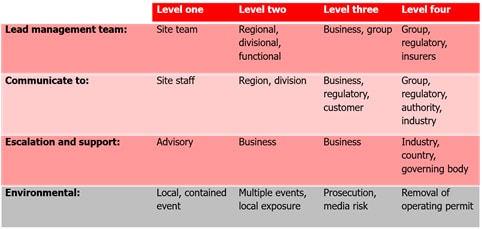
The ability to thrive when facing either opportunity or adversity is a test that many food sector organizations find challenging. With competing priorities and an ever-shifting landscape of consumer demands, even small unexpected events can send people scrambling.
Developing an escalation matrix can be an effective way of determining the level of escalation needed and reduce confusion when every minute matters. The complexity of the matrix depends on a number of factors including the size of your business (number of sites and staff), number of products made, depth of supply chain, production volumes and more.
Escalation levels can be coded by number, colour or something that makes specific reference to an organization’s culture. Whatever the choice, keep it simple so it can be easily recalled when stress levels are high. For each level, determine which teams need to be involved or aware, and, possibly, external parties (e.g. regulatory, consumers, nearby businesses or residents).
As the number of levels of escalation shouldn’t be numerous, assigning these across the top of the matrix, running left to right is likely practical. Which teams and external parties need to be involved can be in the same cell, or they can be listed in the first rows for clarity.
The next step will be to consider threats. The challenge here is not to be too specific or too broad as either can lead to confusion. But the key is to think about all aspects of the organization: product, people, process as well as external parties. Using an environmental issue as an example, if the list included every potential type of problem (e.g. incorrect disposal of waste, chemical leak, fuel spill, etc.), when extended to include other non-environmental threats the escalation matrix becomes too complex.

Unless the teams managing and reacting to these would be different, as shown in Figure 1 it makes sense and provides clarity to group them into one threat of ‘environmental’ and use the escalation indicators of: local, contained event; multiple events with local exposure; prosecution and media risk; and cancellation as you move across the matrix from minor to significant. As noted above, the number of threats included in your matrix will be determined by the size and nature of your organization.



